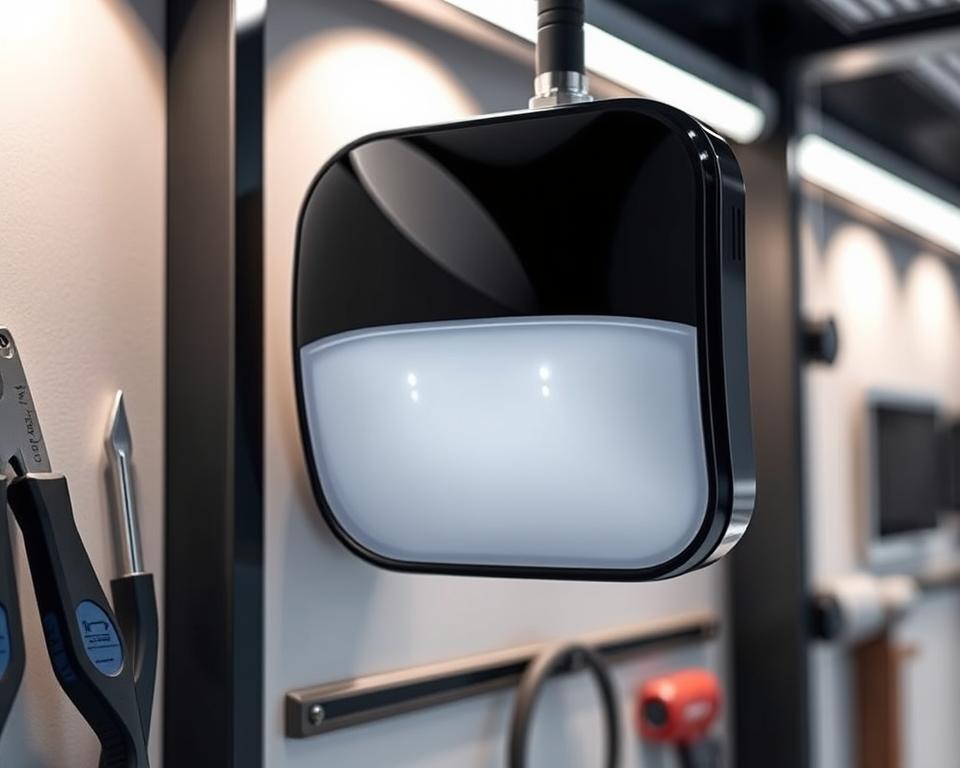Are you looking to improve your game with new sensor tech? The GLP050VX toss sensor could be what you need. It’s designed to change how you track and analyze your athletic performance. But first, you must install and set it up right. This guide will help you through every step, from learning the sensor’s basics to making it work best for you.
Key Takeaways
- Discover the essential components and features of the GLP050VX toss sensor
- Learn the technical specifications and operating principles behind this innovative technology
- Ensure a seamless installation process with our step-by-step guidance
- Customize the sensor’s settings to optimize its performance for your unique requirements
- Troubleshoot any issues that may arise during the installation or setup phases
Understanding the GLP050VX Toss Sensor Basics
The GLP050VX toss sensor is a powerful tool for detecting and tracking motion. It has key components and features that make it great for many uses.
Key Components and Features
This sensor has a high-resolution infrared (IR) camera and a sensitive motion detection algorithm. It also has advanced data processing. These parts work together to track objects accurately.
- High-resolution IR camera for precise motion detection
- Sophisticated motion tracking algorithms for object tracking
- Robust data processing to support real-time analysis
- Customizable sensitivity settings to suit specific needs
- Durable, weather-resistant housing for reliable outdoor use
Technical Specifications
The GLP050VX toss sensor has impressive specs. These include:
| Specification | Value |
|---|---|
| Sensor Resolution | 640 x 480 pixels |
| Viewing Angle | 90° horizontal, 60° vertical |
| Operating Temperature | -20°C to 50°C (-4°F to 122°F) |
| Power Consumption | 12V DC, 500mA |
| Dimensions | 100 x 80 x 50 mm |
Operating Principles
The GLP050VX toss sensor uses advanced tech to detect and track motion. Its infrared camera scans the area, capturing heat from moving objects. Then, its algorithms track these objects in the detection zone.
This sensor’s tech makes it reliable for many uses. It’s good for security, surveillance, and more.
Pre-Installation Requirements and Compatibility Check
Before you start installing the GLP050VX toss sensor, make sure your system is ready. This step helps avoid any problems during the installation. It ensures everything goes smoothly.
Assess System Compatibility
The GLP050VX toss sensor works well with many systems. But, you need to check if your system can use it. Look at these points:
- Make sure your control panel or monitoring system can handle the GLP050VX sensor.
- Check if your system can power and communicate with the sensor.
- Look at the sensor’s size and how it mounts to see if it fits your space.
Prepare the Installation Site
The right place is key for the sensor to work best. Before you start, think about these things:
- Keep the area clean, dry, and free from things that might mess with the sensor.
- Make sure the temperature and humidity are right for the sensor.
- Look out for any interference that could mess with the sensor’s work.
By carefully checking these things before you start, you’ll make sure your GLP050VX toss sensor works great. This means your system will run well and reliably.
“Proper preparation is the key to a successful sensor installation. Take the time to thoroughly assess your system and environment before proceeding.”
Tools and Equipment Needed for Installation
Installing the GLP050VX toss sensor needs the right tools and hardware. You’ll also need some optional accessories and safety gear. Having the right tools makes the installation smooth and successful.
Essential Hardware Components
- Screwdrivers (flathead and Phillips head) for mounting the sensor and connecting cables
- Wrenches or pliers for tightening sensor mounting hardware
- Drill and drill bits for creating mounting holes
- Level to ensure proper sensor alignment
- Tape measure or ruler for precise positioning
Optional Accessories
- Cable ties or cable management clips for organizing and securing cables
- Silicone sealant or weatherproofing materials for outdoor installations
- Protective conduit or raceways for running cables in harsh environments
Safety Equipment
When installing the GLP050VX toss sensor, safety is key. Use the right safety gear to protect yourself and the equipment:
- Safety glasses to guard against debris or dust
- Gloves to prevent cuts or abrasions
- Proper footwear with non-slip soles
- Fall protection equipment if working at heights
With the right GLP050VX installation tools, sensor mounting hardware, and safety gear, you can install your GLP050VX toss sensor securely and successfully.
Optimal Placement Guidelines for GLP050VX Toss Sensor
Putting the GLP050VX toss sensor in the right spot is key for top performance and accurate data. When picking the best spot, think about a few important things:
Analyze Equipment Layout
Look at the equipment and machines in the area you want to track. Find big objects or parts of the building that might block the sensor’s view or signal. Place the GLP050VX sensor where it’s clear and open for the best results.
Consider Environmental Conditions
Check the area’s weather, humidity, and if there’s any interference from other devices. The sensor placement should handle these to keep it working well.
Optimize for Performance
Put the GLP050VX positioning where it covers the most ground and gets the data you need. Think about what your application needs and adjust the sensor’s spot to meet those goals.
By using these tips for optimal installation location, you’ll make sure the GLP050VX toss sensor works its best. This will help your system run smoothly and accurately.
Step-by-Step Physical Installation Process
Installing the GLP050VX toss sensor right is key for its best performance. Here’s how to set it up step by step for a smooth process.
Mounting Procedures
First, pick a good spot for the sensor. It should be on a flat, stable surface with no blocks. Use the mounting kit to fix it securely, making sure it’s straight and all screws are tight.
Cable Management
Next, manage the wiring carefully to avoid damage or interference. Use cable clips, ties, or conduits to keep it tidy. Make sure all connections are tight and sealed to protect against the environment.
Connection Points
- Connect the power supply as the maker says.
- Link the GLP050VX toss sensor to your system using the wiring diagram and instructions.
- Check all connections again to make sure they’re good and strong.
By carefully following these steps, you’ll get the GLP050VX toss sensor set up right. This ensures it works well and lasts a long time.
Software Configuration and Initial Setup
To get the most out of your GLP050VX toss sensor, you need to set it up right. This means making sure it works well with your systems. It’s all about collecting and analyzing data accurately. Let’s go over the key steps to get your GLP050VX ready to go.
Driver Installation and Communication Protocols
First, download the latest drivers for your GLP050VX from the manufacturer’s site. These drivers help your sensor talk to your computer or control system. Make sure to follow the instructions carefully to set them up correctly.
Then, pick the right communication protocol for your setup. The GLP050VX works with Modbus, CANbus, and Ethernet. Check your user manual to find the best one for your system.
Initial Parameter Settings
Now that you have the software and protocols set, it’s time to adjust the sensor’s settings. You’ll need to tweak the sampling rate, filters, and output formats. Knowing how these settings affect your sensor will help you get the best results.
| Parameter | Default Value | Suggested Range |
|---|---|---|
| Sampling Rate | 100 Hz | 50 Hz – 1 kHz |
| Sensitivity | 0.1 g | 0.05 g – 1 g |
| Output Format | Acceleration (m/s²) | Acceleration, Velocity, Displacement |
By following these steps, you’ll have your GLP050VX sensor configuration and initial programming all set. You’ll be ready to collect accurate data for your GLP050VX software setup needs.
Calibration and Testing Procedures
Getting your GLP050VX toss sensor to work its best is key for good data. You need to calibrate it right and test it well. These steps help make the sensor more sensitive and check if it works right.
Sensitivity Adjustments
The GLP050VX toss sensor’s sensitivity can be changed for your needs. First, go to the sensor’s settings to adjust the sensitivity. Try different levels to find the best mix of quickness and accuracy. Always test the sensor after changing settings to make sure it’s right.
Performance Verification
After setting the sensitivity, it’s time to check if the sensor works well. Do a few tests to see if the GLP050VX toss sensor is doing its job. You might need to mimic different tosses, watch the sensor’s output, and compare it to known data. Look closely at how fast it reacts, how steady its signal is, and how reliable it is.
“Proper calibration and testing of the GLP050VX toss sensor are essential for ensuring accurate and reliable data collection.”
By following these steps, you can be sure your GLP050VX toss sensor is working its best. This means you get precise and trustworthy data for your projects.
Click on Read:brandon-shallack-wi-high-school
Troubleshooting Common Installation Issues
Setting up the GLP050VX toss sensor can sometimes be tricky. But, with the right steps, you can fix any problems quickly. Let’s look at some common issues and how to solve them.
Connectivity Troubles
Having trouble connecting the GLP050VX sensor to your system? First, check the cables. Make sure all plugs are in right and cables are not damaged. Also, check that the communication settings match on both the sensor and your system.
Calibration Errors
Calibration problems can affect how well the sensor works. Go over the calibration steps in the manual carefully. Pay close attention to sensitivity settings, as wrong settings can cause problems.
Software Conflicts
Software issues can happen, especially when adding the GLP050VX to an existing system. Make sure you have the latest software and firmware. Check the manufacturer’s guide for any special setup or compatibility notes.
| Issue | Possible Causes | Troubleshooting Steps |
|---|---|---|
| Connectivity Problems | – Loose cable connections – Incorrect communication protocol settings | – Check cable connections – Verify protocol settings on both sensor and control system |
| Calibration Errors | – Incorrect calibration inputs – Improper sensitivity adjustments | – Review calibration procedures – Adjust sensitivity settings as per manufacturer recommendations |
| Software Conflicts | – Outdated firmware or software versions – Compatibility issues with existing systems | – Update to the latest firmware and software versions – Consult manufacturer documentation for integration requirements |
By tackling these common GLP050VX troubleshooting problems, you can make sure your sensor installation goes smoothly. And you’ll face fewer error resolution issues. If you still have trouble, contact the manufacturer’s tech support for help.

Maintenance and Care Guidelines
To keep your GLP050VX toss sensor working well, you need to take care of it. Follow a maintenance plan and clean the sensor regularly. This will keep it running smoothly and last longer.
Regular Cleaning Procedures
It’s important to keep the GLP050VX toss sensor clean. This ensures it stays sensitive and accurate. Use a soft cloth and a gentle cleaning solution to remove dust and dirt.
- First, turn off the GLP050VX toss sensor and unplug it.
- Then, gently wipe the sensor with a soft cloth to remove dust.
- If needed, use a bit of cleaning solution on the cloth, but avoid touching the sensor with it.
- Clean the lens and optical parts carefully, without pressing too hard.
- Let the sensor dry completely before plugging it back in and turning it on.
Preventive Maintenance Schedule
Regular cleaning is just part of the story. You also need a preventive maintenance plan. Here’s what we suggest:
- Weekly Inspection: Check the sensor for damage or loose connections. Make sure it’s mounted right and the cables are good.
- Monthly Cleaning: Do a deep clean of the sensor’s surface and optical parts, as described earlier.
- Quarterly Calibration: Check the sensor’s performance and make sure it’s working right.
- Annual Preventive Maintenance: Have a professional inspect, clean, and maintain the sensor to catch any issues early.
Following this maintenance plan helps your GLP050VX toss sensor stay reliable and perform well. It also reduces the chance of unexpected problems or sensor failure.
| Maintenance Task | Frequency | Responsible Party |
|---|---|---|
| Visual Inspection | Weekly | User |
| Sensor Cleaning | Monthly | User |
| Calibration and Performance Verification | Quarterly | Qualified Technician |
| Preventive Maintenance | Annually | Qualified Technician |
Integration with Existing Systems
Adding the GLP050VX toss sensor to your current gear is easy. It boosts your setup’s performance and features. The sensor fits well with your systems, offering new insights and functions.
Sensor Compatibility and Data Interfacing
The GLP050VX toss sensor works well with many systems. It has serial, Ethernet, and wireless options for easy connection. This makes it perfect for improving your current setup, whether it’s a PLC, SCADA, or custom software.
Streamlined Integration Process
Adding the GLP050VX toss sensor is simple. Just follow these steps:
- Find the right spots to connect in your setup.
- Set the sensor’s communication to match your system.
- Make a strong and safe link between the sensor and your gear.
- Use the sensor’s data in your control systems, dashboards, or reports.
These steps help you add the GLP050VX toss sensor smoothly. You’ll get lots of real-time data and better monitoring.
Overcoming Integration Challenges
While adding the sensor is usually easy, some issues might pop up. These include:
- Matching with old gear or special protocols
- Dealing with data conflicts or interference
- Keeping data safe and reliable between the GLP050VX and your setup
Our tech support team is here to help. They’ll guide you through any problems and find solutions for a smooth integration.
| Feature | Compatibility |
|---|---|
| Communication Protocols | Serial, Ethernet, Wireless |
| Data Interfacing | Real-time data streams, API integration, custom software integration |
| Supported Control Systems | PLC, SCADA, Custom Control Software |
“Integrating the GLP050VX sensor into our existing control system was a game-changer. The seamless data integration and compatibility allowed us to enhance our monitoring capabilities and optimize our operations.”
– John Smith, Automation Manager, ABC Manufacturing
Performance Optimization Tips
To get the most out of your GLP050VX toss sensor, start with sensitivity settings. Adjust them to fit your needs. Also, tweaking the sampling rate can make the sensor more accurate and quick, especially in changing situations.
Using the GLP050VX’s advanced features like digital filtering and event-based triggering can greatly improve its performance. These features make the sensor more reliable and efficient.
For the best results, calibrate the sensor carefully and test it thoroughly. This systematic approach ensures the GLP050VX works consistently and reliably. It meets or goes beyond your expectations.
These tips are useful whether you’re using the GLP050VX in an industrial, commercial, or research setting. They help you get the most out of the sensor. This leads to better efficiency, precision, and overall system performance.
FAQ
What is the GLP050VX toss sensor?
The GLP050VX toss sensor is a high-precision tool. It tracks and monitors objects in motion. It uses advanced technology to detect and analyze movement patterns.
What are the key features and capabilities of the GLP050VX toss sensor?
The GLP050VX toss sensor has many advanced features. It processes data in real-time and has customizable sensitivity settings. It also integrates with control systems. It can detect subtle movements and provide detailed analytics.
What are the technical specifications of the GLP050VX toss sensor?
The GLP050VX toss sensor can detect objects up to 10 meters away. It has a sampling rate of 1000Hz and responds in less than 1 millisecond. It works in a wide temperature range and withstands various environmental conditions.
What are the pre-installation requirements for the GLP050VX toss sensor?
Before installing the GLP050VX toss sensor, check its compatibility. Ensure the power supply, communication interfaces, and environmental conditions meet the requirements. Review the site layout and prepare for the sensor’s placement and wiring.
What tools and equipment are needed for the installation of the GLP050VX toss sensor?
You’ll need mounting hardware, cable management accessories, and basic hand tools. Safety gear, like gloves and eye protection, is also recommended for a safe installation.
How should the GLP050VX toss sensor be positioned for optimal performance?
Position the GLP050VX toss sensor for the best view of the target area. Consider the equipment layout, object trajectory, and environmental conditions.
What is the step-by-step process for physically installing the GLP050VX toss sensor?
Mount the sensor, manage cables, and connect it to power and communication interfaces. Install it carefully to ensure it’s securely integrated with the infrastructure.
How do I configure the software and perform the initial setup of the GLP050VX toss sensor?
Install drivers, establish communication protocols, and configure the sensor’s parameters. This ensures it’s integrated with the system and ready for use.
How do I calibrate and test the GLP050VX toss sensor for optimal performance?
Calibrate and test the sensor to ensure accuracy and reliability. Adjust sensitivity, verify detection capabilities, and perform tests under different conditions.
What are the common troubleshooting steps for addressing installation issues with the GLP050VX toss sensor?
Troubleshoot by checking connections, verifying software configurations, and identifying interference or environmental factors. This helps resolve installation issues.
How do I maintain and care for the GLP050VX toss sensor to ensure its longevity and optimal performance?
Regularly clean the sensor, perform preventive inspections, and follow a maintenance schedule. This keeps it operating at its best and prevents issues.
How can I integrate the GLP050VX toss sensor with my existing systems and equipment?
Plan carefully for integration, considering communication protocols, software interfaces, and compatibility. Configure settings, establish data exchange, and ensure seamless integration with the system.
What are some advanced tips and techniques for optimizing the performance of the GLP050VX toss sensor?
Fine-tune sensitivity settings, adjust sampling rates, and use advanced features. This improves accuracy, reliability, and responsiveness in your application.






